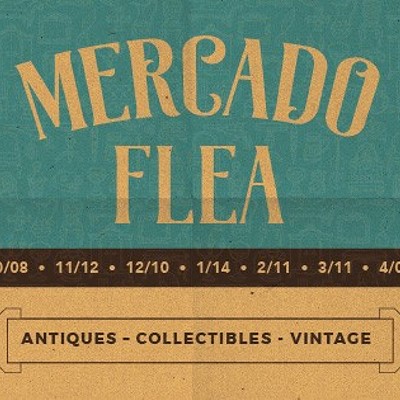Passionate purple, outrageous orange, blissful blue, effervescent earth green, luminescent yellow: great thick gobs of color lobbed onto canvases with brushes and spatulas, and ploughed into furrows with combs and even the artist's fingers. Glowing underpaintings in blue or lavender, stained onto the cloth, shining through the thick overpainting above.
But one of the most arresting paintings in Waid's show Natural Selections at the Louis Carlos Bernal Gallery at Pima Community College is black and white all over. Or at least you think it is at first glance.
"Sonoran Bones," 2003, is a splendid work, giant-sized at 6 feet high by 7 feet wide. Like all nine paintings in this exuberant exhibition, it's an acrylic on canvas, but unlike the others, it conjures up the glories of the desert in a minimalist palette. Black and white lines, jumpy and energetic, dart all over the surface, sketching out a Sonoran landscape that positively vibrates. A young, armless saguaro rises up at left; the long stalks of ocotillos are dancing everywhere; the sloping mountain in the distance easily evokes the westside of Tucson.
Waid lavished a thick impasto of white atop the black underpainting, and "drew" the desert's bones by pushing through the wet white paint to reveal the black below. And it turns out it's not just black under there. This artist can't resist color for long. Passages of denim blue start showing up when you inspect the painting closely, then a flick of red, a splash of purple.
A show of Waid paintings is a rare event in the town he's called home for 40 years. He does have two public-art pieces permanently on display in Tucson. A huge desert canvas is upstairs at the Evo DeConcini Federal Courthouse downtown, but the feds crammed it over a staircase, and you can't stand back far enough to see it well (and you have to go through a rigorous security check just to get in). A second painting, which I haven't seen, is at the Columbus Branch library.
The artist shows elsewhere around the country, and he regularly exhibits works on paper at Etherton. (A companion show of pastels, watercolors and paintings on paper is up right now at the Etherton-run Temple Gallery.) But a contractual agreement with his Scottsdale gallery, Riva Yares, prevents him from showing his paintings on canvas here. Lucky for us, a loophole allowed him to put the big paintings at Pima. It's a college, not a for-profit gallery.
The homecoming has special resonance for Waid, who taught at the college in the 1970s. He has often told the tale of how he took his Pima students outside into the surrounding desert to draw. An Oklahoma boy born and bred, he found himself "seduced" by the surreal cacti and desert light, he writes in the show's catalog. "I found my artistic voice in the arroyos, hills and canyons surrounding Tucson. The early morning hikes down a wash, the sun breaking over a hill lighting up vegetation with psychedelic halos."
Case in point is "Summer Torch," 2006, a giddily joyous painting in yellow. Plants in red, purple and green gyrate across the delirious yellow like streamers tossed at a party. The earth below is rich in purple and burnt sienna, and a flower explodes in white and lavender. You'd never see this scene in real life in your own walks out into the desert hills--though a springtime wildflower hike might come close. Instead, Waid abstracts the desert, distilling its heat and light and magnifying its spiky forms.
"Summer Torch," relatively small at 5 feet high by 3 1/2 feet wide, zeroes in on just a few plants, but "Westfork," 2002, rolls out an entire landscape. It's big--6 1/2 feet high by 10 feet wide--and an arroyo meanders invitingly all across its length, creating a bold, curving diagonal in reds and pinks. Fantastical flowers and plants erupt all around it, their golden yellows, flag reds and violets ablaze. Waid has given "Westfork" the depth and dimension of a real place. A viewer could walk right in.
Even so, the painting is also about paint. A series of white and purple shapes--fish or rocks?--with their specks and drips and lines of color are as abstract as Pollock's drizzled paintings on drop cloth. The deep blues and greens of the foreground are sustained passages of pure color, and even the pink, recognizable as a path, is a delicious agglomeration of brushstrokes and hues, from pale ocher to dark peach. The wild brushtrokes flail out in all directions.
"Daybreak," 2001, is another big painting, 7 feet by 11 feet, but it's less a landscape than a compilation of desert beauties. Like "Summer Torch," it has an intoxicating yellow light. A giant butterfly in blue and orange, fluttering near the center, has one of those psychedelic halos. White blossoms burst open like fireworks. Confetti, colored lemon yellow and blue, flings itself everywhere in an excess of joy.
The same giant flowers and butterflies get solo billing in the recent works on paper at the Temple Gallery. Waid often works out his ideas in the smaller pieces before committing them to monumental canvas, so the two-show Waid festival is instructive. But the motifs flow in both directions.
The "Hot House" series of acrylics on paper from 2008 updates some of the images from the Pima show, which covers the last 10 years. With its curving petals and stems, the red and purple flower in "Hot House No. 1" is a close cousin of the butterfly in "Daybreak," but even more brilliant, if possible. "Dark Star," 2008, re-examines the nighttime palette in the silvery "Moonstones," 2007, in the Pima show. The lovely "Narcho's Blues," a pungent pastel on board from 2008, pays homage to the late Tucson artist Dean Narcho. It reprises Narcho's wild dots and swirls in Waid-ian royal blue and maroon, giving tantalizing hints of Waid paths yet to be traveled.












